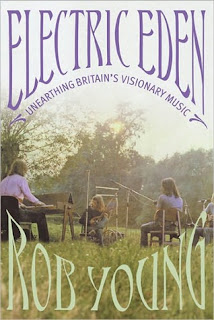THE best of it still sounds as fresh as the day its long-haired practitioners pulled out their mandolins and plugged in the amps: British folk rock is one of the great unsung stories, at least in this country. The new book, Electric Eden: Unearthing Britain’s Visionary Music, gets at the movement’s greatest musicians — Vashti Bunyan, Richard Thompson, Nick Drake, Fairport Convention, Bert Jansch, Anne Briggs, many others — and connects them to currents deep in British literary and cultural life, including the resistance to industry, the flight to the landscape and the search for a distinctively British (and sometimes pre-Christian) culture.
This is a wonderful and well-researched book, though like the music it chronicles, it rambles a bit. It’s hard to imagine an American publisher allowing this much backstory — William Morris, Holst, druids, etc. (The book is put out by FSG in this country but is primarily a reprint of a Faber and Faber book published previously in the UK.)
And while this was not the book’s primary goal — which was to chart the late ’60s/early ’70s heyday of British folk rock — I would have liked to see a bit more on the contemporary scene. Gen X West Coast artists in particular — Stephen Malkmus, The Decemberists, Joanna Newsom, Devendra Banhart — have been voracious at consuming and reviving this stuff otherwise ignored by the marketplace. (It recalls to me the way Boomer musicians both in Britain and America helped bring black blues figures — Lonnie Johnson, Son House, Mississippi John Hurt — back into the light in the ’60s.)
 All very different: Drake is Romantic in the original sense, and his “River Man” is a haunting and supernatural vision, with the ghostly string arrangements of Harry Robinson. Martyn is ecstatic and almost funky, using his Echoplexed acoustic guitar for the first time in scintillating patterns. Fairport’s album is one of the cornerstones of modern English folk, with rocked-up ballads and wistful, melancholic songs written in a traditional idiom.
All very different: Drake is Romantic in the original sense, and his “River Man” is a haunting and supernatural vision, with the ghostly string arrangements of Harry Robinson. Martyn is ecstatic and almost funky, using his Echoplexed acoustic guitar for the first time in scintillating patterns. Fairport’s album is one of the cornerstones of modern English folk, with rocked-up ballads and wistful, melancholic songs written in a traditional idiom.  |
| The Incredible String Band |
Where can we hear the legacy of this period in contemporary music? Did it leave any traces in mainstream – or not so mainstream – culture or thinking in Britain or the States?


I’ve been listening to a lot of British Folk in anticipation of reading this book later this month.
Britain produced a lot of wonderful folk/folk-rock music in the late 60s and early 70s: Nick Drake, Fairport Convention, Steeleye Span and Pentangle are among the best remembered.
The music of The Incredible String Band is very difficult to approach, but still rewarding. There are also many nearly forgotten acts like Dr. Strangely Strange, Trees, Forest, that perhaps don’t hold up as well as the music of Nick Drake or Fairport, but are still serve as a weird and wonderful time capsule of the period.
I’m really looking forward to reading the book, and I appreciate that there is so much back story included. I think that, as an American, a lot of things about the music of Britain, and especially music that draws on the island’s distant past, is really mysterious, and also easy to misunderstand.
I do think to really understand the music of ISB or Fairport, you have to consider Britain’s long history and rich mythic tradition, as well as the reality of what life was like in industrialized Britain in the 19th and 20th Centuries (largely depressing).
Thanks for raising the profile of this book. Your coverage of it was much, much more intelligent than the piece that showed up in the NYTimes written by Bill Wyman (not the Stone).
Thanks Pete… Those other bands you mentioned are well covered in this book — it’s nothing if not complete. And Young makes those connections to the mythic tradition, etc, quite well.
The music of Richard Thompson and to some extent Fairport hit me hard as an American suburban teenager in the mid-80s, heard on the radio in between Elvis Costello and R.E.M. But living in England certainly deepened my understanding of it, and allowed me to dig people like Bert Jansch and the gloomy Mr. Drake.
Still, I continue to have trouble really connecting with the Incredible String Band.